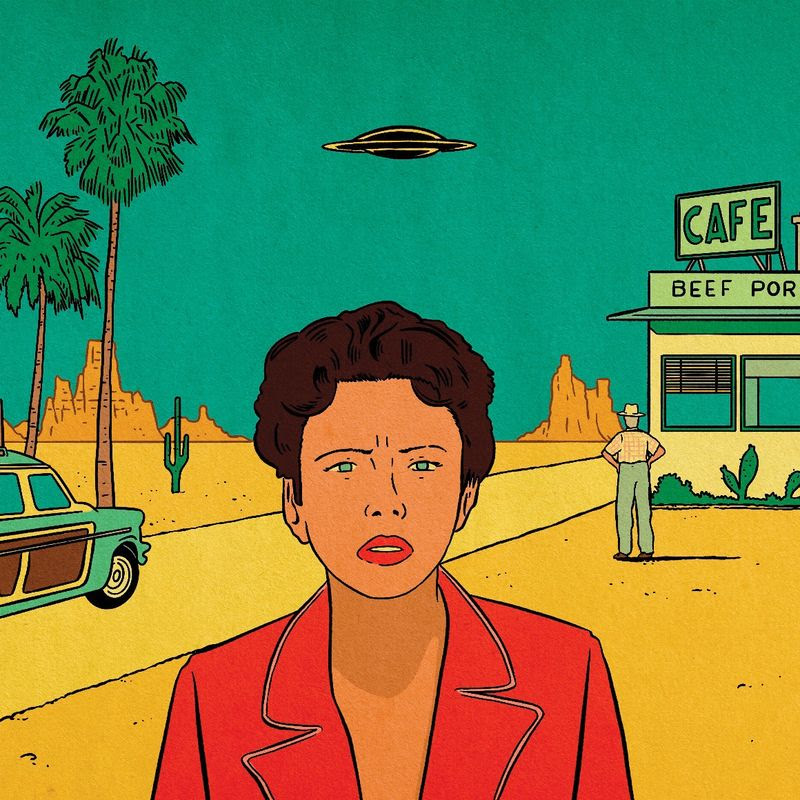The Current Cinema |
By Anthony Lane |
In “Asteroid City,” Humans Can Leave Impact Craters, Too
Like pretty much everything about the new Wes Anderson film, “Asteroid City,” the title is a joke. Asteroid City is not a city but a dusty town, a stone’s throw from the middle of nowhere, with a population of eighty-seven, a luncheonette, and a motel where you can get milk, Martinis, and real estate from vending machines. And what crashed in this remote spot, nearly five thousand years ago, was not an asteroid but a meteorite, the size of a crystal ball. So, who shows up here, in the course of the plot? Apart, that is, from the widower with his late wife’s ashes in a Tupperware bowl, the blazing Hollywood star, the eccentric kids and their futuristic inventions (not least a functioning ray gun), the warbling cowboys, and the government agents who plunge everyone into quarantine? Nobody, really. Unless that green glow in the film’s trailer turns out to be an alien spaceship, bearing someone, or something, who stops to pose for a picture. But that would be absurd.
The year is 1955, an era when a merry mushroom cloud can billow upward, in the background, signalling the test of an atomic bomb, without causing undue alarm. The widower is Augie Steenbeck (Jason Schwartzman), a pipe-smoking war photographer. He has three little daughters, a precocious son, Woodrow (Jake Ryan), and a car that just broke down. Also staying in Asteroid City is Midge Campbell (Scarlett Johansson), a famous actress who reduces lesser mortals to mutterings of awe, and her daughter, Dinah (Grace Edwards). In a neat romantic arrangement, Dinah falls for Woodrow, with whom she shares a penchant for the extraterrestrial, while Augie loses his heart to Midge. Their courtship is largely conducted across the space between two motel cabins; this allows them to be framed in windows, as if they were stuck in their own private movies.
The framing does not end there. “Asteroid City,” we learn, owes its existence to a stage play, written by Conrad Earp (Edward Norton), whose creative labors are described to us by a narrator (Bryan Cranston). How, precisely, the film locks into the play, why we first see the play on a TV monitor, and whether it’s the same play that is overseen by a debonair director, Schubert Green (Adrien Brody), are narrative niceties that must await clarification from viewers much smarter than me. I was content, more or less, to sit back in dumb delight, and to savor the textural contrast between the black-and-white crispness of the theatre scenes and the powdery, sherbet-like colors, loud but never deep, in which Asteroid City is steeped. Of particular note is the aquamarine that pops up everywhere—overlaid with a pattern of pink diamonds, if you please, on the pants heroically sported by Tom Hanks, in his role as Augie’s father-in-law, Stanley Zak.
The movie, believe it or not, was shot in Spain. But can you believe? Are those genuine roads, leading out of Asteroid City, and do they stretch to an actual horizon? The pastel flatness of the landscape, as an arena for spasms of nuttiness, is akin to that of Pixar’s “Cars” saga or a Road Runner cartoon—a kinship made explicit by the roadrunner that hops in and out of sight. Beep-beep! You could try cataloguing Anderson’s references to other works of art (not just films), but beware: your quest, like Wile E. Coyote’s, is doomed from the start. The opening credits, during which a train hustles through the desert, pay blatant tribute to those of “Bad Day at Black Rock” (1955), the only slight kink being that Anderson’s train is ferrying avocados and a nice, ripe nuclear warhead. A caution on the side reads “do not detonate,” which happens to be the title of a batch of recent screenings at the Museum of the Moving Image, devised to herald the release of “Asteroid City.” The films included “Ace in the Hole” (1951), “The Misfits” (1961), and, yes, “Bad Day at Black Rock.”
All of which will leave some prospective moviegoers asking, “You mean we have to do homework?” Others will be less concerned by what went into “Asteroid City” than by what emerges at the other end. All the characters seem to have attended Anderson School, so to speak, where the need for underreaction, clipped and quick, has been drummed into them; that would explain why Augie’s young daughters barely flinch, let alone cry, when they hear of their mother’s demise. Such a conceit—that emotions can be as stylized as clothes—is not a fault so much as a sly strategy. (You encounter it all the time in Restoration comedy.) Now and then, however, I couldn’t help yearning for the tough, sombre inhabitants of “Bad Day at Black Rock”: Spencer Tracy, Robert Ryan, Ernest Borgnine, and Lee Marvin. When Tracy, one-armed and clad in funereal black, strikes Borgnine and sends him reeling through the doorway of a bar, with Ryan holding steady at the pinball machine beside them, the director, John Sturges, positions his figures with Andersonian care, but there’s a meaty moral tension in the fray. These guys are not fooling. Who, in “Asteroid City,” can make that sort of impact?
Scarlett Johansson, that’s who. In most Anderson films, someone stands out from the ensemble; remember how “The Grand Budapest Hotel” (2014) was warmed by the recklessness of Ralph Fiennes. Even if you regard the latest movie as a box of tricks, you have to admire the nerve with which Johansson, as Midge, delves into that box and plucks out scraps of coolly agonized wit. More deftly than anyone else, she traffics in the to-and-fro between the real and the imagined. Lounging in her bath, one arm flung over the rim, she’s a Cold War reboot of “The Death of Marat,” by Jacques-Louis David; elsewhere, she’s costumed and coiffed à la Kim Novak in “Vertigo” (1958). Midge’s lipstick is a shade of pale fire, sometimes paired with a black eye, which is the result not of true violence but, as she admits, a dab of greasepaint—preparation for an acting job, or a fearful sign that, soon enough, fate will take another swing at her? Casually, she mentions having known cruel men, and, when she refers to herself and Augie as “two catastrophically wounded people who don’t express the depths of their pain because we don’t want to,” something in this orderly, scholarly, and hypervigilant movie cracks open. It’s not just meteorites, or aliens, that land in Asteroid City. Humans can leave a crater, too.
Another dry land, another unregarded town, another stack of quirky folk who meet with a mystery. John Slattery’s “Maggie Moore(s),” whose title might prove too fussy even for Wes Anderson, was filmed in New Mexico, and the atmosphere is parched and desperate. Jon Hamm—Slattery’s comrade-in-arms from “Mad Men”—plays a police chief named Sanders. As he and his deputy, Reddy (Nick Mohammed), inspect a charred corpse in a burned-out car, the acrid nastiness catches in your throat.
As with “Asteroid City,” there’s a nagging sense, in “Maggie Moore(s),” of different stories being bundled into a single movie. On the one hand, we have murder most foul: two women, both named Maggie Moore (Mary Holland and Louisa Krause), are found dead, and suspicion falls on their respective husbands, Jay (Micah Stock) and Andy (Christopher Denham). On the other hand, there is circumstantial evidence of love. One of the victims has a next-door neighbor named Rita Grace (Tina Fey), who interrupts the investigation by inviting Sanders to dinner. After a couple of dates, they go to bed. She asks, “Are you ready”—pause—“for the sex?” The answer is no.
What’s remarkable is the sight of Hamm and Fey, who held center stage in two of the most lauded television shows of the century, settling into this shrunken, disconsolate, and deeply unstarry tale. There was a period, running roughly from Clint Eastwood in “Rawhide” to George Clooney in “E.R.,” when the small screen was considered a magic portal to the big one. To claim that the situation has been reversed, and that cinema has now become a retirement home, would be going too far, but it’s noticeable, in “Maggie Moore(s),” that Hamm and Fey play people who have all but dispensed with hope, mislaying self-esteem and encouraging life to sift through their fingers like sand. One is a widower, the other a divorcée. “Losing is kind of the point,” Sanders says, as he and Rita play the slots in a casino. “No, I know,” she replies. “That’s why I fit right in.”
As you’d expect, both actors are highly adept at locating the humor in this sighing pathos. Not that the dialogue ever tightens into the snap of “30 Rock.” What Slattery conjures instead, for some reason, is a continual sourness and decay, which gets into every crevice of the action; Jay, who works at a subs franchise, saves money by buying out-of-date cheese and meat, scabrous with green mold. So heavily does the movie strain for offbeat detail—a killer who watches cartoons at full blast; Jay equipped with a neck brace and a leaf blower—that it refreshes one’s respect for Wes Anderson, whose eye for oddities remains clear and bright. By the end of “Maggie Moore(s),” I was dying for one of those instant Martinis, served by the motel machine in Asteroid City, with an orange twist. ♦



,%E2%80%9D%20Reviewed%20_%20The%20New%20Yorker_files/230626_r42560.jpg)




.png?format=original)